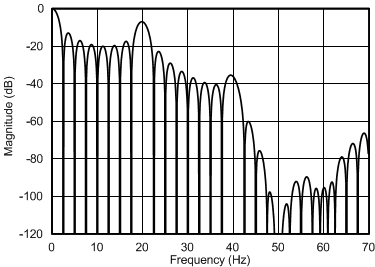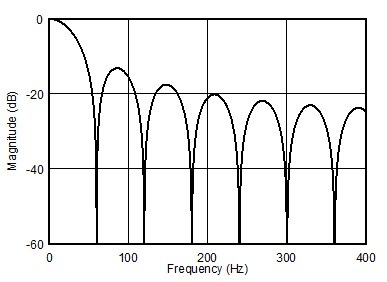SBAS660C August 2016 – June 2017 ADS124S06 , ADS124S08
PRODUCTION DATA.
- 1 Features
- 2 Applications
- 3 Description
- 4 Revision History
- 5 Device Family Comparison Table
- 6 Pin Configuration and Functions
- 7 Specifications
- 8 Parameter Measurement Information
-
9 Detailed Description
- 9.1 Overview
- 9.2 Functional Block Diagram
- 9.3
Feature Description
- 9.3.1 Multiplexer
- 9.3.2 Low-Noise Programmable Gain Amplifier
- 9.3.3 Voltage Reference
- 9.3.4 Clock Source
- 9.3.5 Delta-Sigma Modulator
- 9.3.6 Digital Filter
- 9.3.7 Excitation Current Sources (IDACs)
- 9.3.8 Bias Voltage Generation
- 9.3.9 System Monitor
- 9.3.10 Status Register
- 9.3.11 General-Purpose Inputs and Outputs (GPIOs)
- 9.3.12 Low-Side Power Switch
- 9.3.13 Cyclic Redundancy Check (CRC)
- 9.3.14 Calibration
- 9.4 Device Functional Modes
- 9.5 Programming
- 9.6
Register Map
- 9.6.1
Configuration Registers
- 9.6.1.1 Device ID Register (address = 00h) [reset = xxh]
- 9.6.1.2 Device Status Register (address = 01h) [reset = 80h]
- 9.6.1.3 Input Multiplexer Register (address = 02h) [reset = 01h]
- 9.6.1.4 Gain Setting Register (address = 03h) [reset = 00h]
- 9.6.1.5 Data Rate Register (address = 04h) [reset = 14h]
- 9.6.1.6 Reference Control Register (address = 05h) [reset = 10h]
- 9.6.1.7 Excitation Current Register 1 (address = 06h) [reset = 00h]
- 9.6.1.8 Excitation Current Register 2 (address = 07h) [reset = FFh]
- 9.6.1.9 Sensor Biasing Register (address = 08h) [reset = 00h]
- 9.6.1.10 System Control Register (address = 09h) [reset = 10h]
- 9.6.1.11 Offset Calibration Register 1 (address = 0Ah) [reset = 00h]
- 9.6.1.12 Offset Calibration Register 2 (address = 0Bh) [reset = 00h]
- 9.6.1.13 Offset Calibration Register 3 (address = 0Ch) [reset = 00h]
- 9.6.1.14 Gain Calibration Register 1 (address = 0Dh) [reset = 00h]
- 9.6.1.15 Gain Calibration Register 2 (address = 0Eh) [reset = 00h]
- 9.6.1.16 Gain Calibration Register 3 (address = 0Fh) [reset = 40h]
- 9.6.1.17 GPIO Data Register (address = 10h) [reset = 00h]
- 9.6.1.18 GPIO Configuration Register (address = 11h) [reset = 00h]
- 9.6.1
Configuration Registers
- 10Application and Implementation
- 11Power Supply Recommendations
- 12Layout
- 13Device and Documentation Support
- 14Mechanical, Packaging, and Orderable Information
Package Options
Refer to the PDF data sheet for device specific package drawings
Mechanical Data (Package|Pins)
- RHB|32
- PBS|32
Thermal pad, mechanical data (Package|Pins)
Orderable Information
9.3.6.1.1 Low-Latency Filter Frequency Response
The low-latency filter provides many data rate options for rejecting 50-Hz and 60-Hz line cycle noise. At data rates of 2.5 SPS, 5 SPS, 10 SPS, and 20 SPS, the filter rejects both 50-Hz and 60-Hz line frequencies. At data rates of 16.6 SPS and 50 SPS, the filter has a notch at 50 Hz. At a 60-SPS data rate, the filter has a notch at 60 Hz.
For detailed frequency response plots showing line cycle noise rejection, download the ADS1x4S0x design calculator from www.ti.com.
Figure 54 to Figure 68 show the frequency response of the low-latency filter for different data rates. Table 12 gives the bandwidth of the low-latency filter for each data rate.

| fCLK = 4.096 MHz, low-latency filter |
Data Rate = 2.5 SPS

| fCLK = 4.096 MHz, low-latency filter |
Data Rate = 10 SPS

| fCLK = 4.096 MHz, low-latency filter |
Data Rate = 20 SPS

| fCLK = 4.096 MHz, low-latency filter |
Data Rate = 50 SPS

| fCLK = 4.096 MHz, low-latency filter |
Data Rate = 100 SPS

| fCLK = 4.096 MHz, low-latency filter |
Data Rate = 400 SPS

| fCLK = 4.096 MHz, low-latency filter |
Data Rate = 1 kSPS

| fCLK = 4.096 MHz, low-latency filter |
Data Rate = 4 kSPS

| fCLK = 4.096 MHz, low-latency filter |
Data Rate = 5 SPS

| fCLK = 4.096 MHz, low-latency filter |
Data Rate = 16.6 SPS

| fCLK = 4.096 MHz, low-latency filter |
Data Rate = 20 SPS, Zoomed to 50 Hz and 60 Hz

| fCLK = 4.096 MHz, low-latency filter |
Data Rate = 60 SPS

| fCLK = 4.096 MHz, low-latency filter |
Data Rate = 200 SPS

| fCLK = 4.096 MHz, low-latency filter |
Data Rate = 800 SPS

| fCLK = 4.096 MHz, low-latency filter |
Data Rate = 2 kSPS
Table 12. Low-Latency Filter Bandwidth
| NOMINAL DATA RATE (SPS)(1) | –3-dB BANDWIDTH (Hz)(1) |
|---|---|
| 2.5 | 1.1 |
| 5 | 2.2 |
| 10 | 4.7 |
| 16.6 | 7.4 |
| 20 | 13.2 |
| 50 | 22.1 |
| 60 | 26.6 |
| 100 | 44.4 |
| 200 | 89.9 |
| 400 | 190 |
| 800 | 574 |
| 1000 | 718 |
| 2000 | 718 |
| 4000 | 718 |
The low-latency filter notches and output data rate scale proportionally with the clock frequency. For example, a notch that appears at 20 Hz when using a 4.096-MHz clock appears at 10 Hz if a 2.048-MHz clock is used. Note that the internal oscillator can vary over temperature as specified in the Electrical Characteristics table. The data rate, conversion time, and filter notches consequently vary by the same percentage. Consider using an external precision clock source if a digital filter notch at a specific frequency with a tighter tolerance is required.